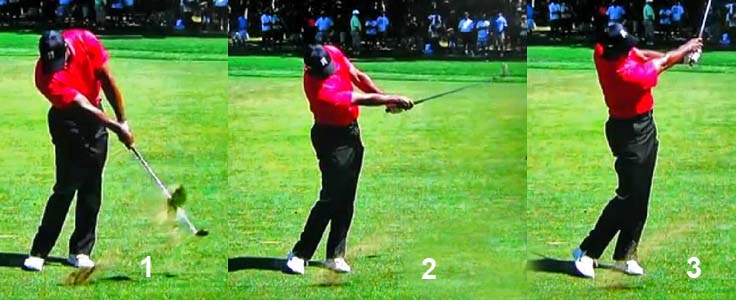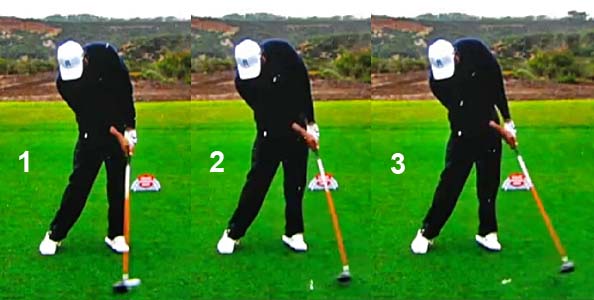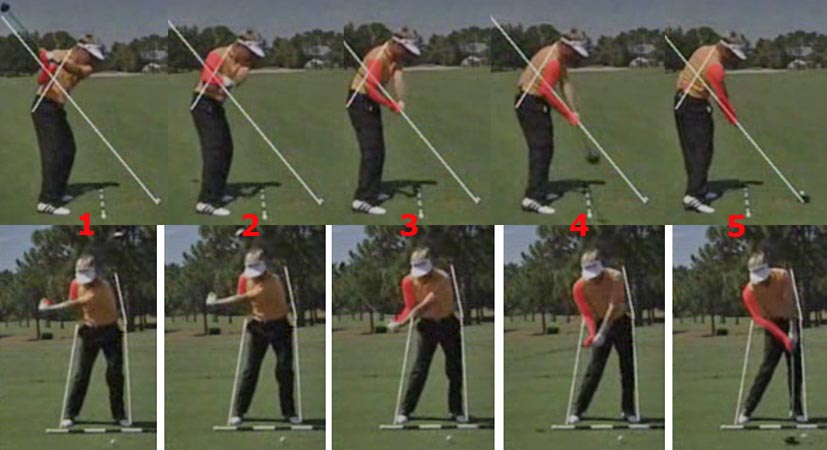|
|
Post by imperfectgolfer on Jan 30, 2013 15:04:09 GMT -5
Greg, You wrote (in the BM-forum thread) regarding the following video of Tiger (taken from upline and a back-side-angle) that you had difficulty seeing what is happening to his left wrist. I think that it is very easy to see what is happening to his left wrist if you use the manual toggle control in a swing analyser program. One can see the "exact" moment when his left wrist bends - and it happens at about P7.3. Here are capture images.  Image 1 is at impact, and he has a FLW facing the target. Image 2 is at P7.1 and he still has a FLW facing targetwards, but it has rolled counterclockwise to a small degree. Image 3 is at P7.2 and it shows that he still has a FLW, which has rolled even more clockwise, thereby causing the clubface to roll closed. Image 4 is at P7.3 and his left wrist is starting to bend - it is much easier to see it happening when toggling the control in a swing analyser program. Image 5 is at P8 and he obviously has a bent left wrist. In a previous post, I demonstrated that Tiger maintained a FLW beyond P7.5+ when hitting a short iron. Here are the capture images.  The reason why he can maintain a FLW for such a prolonged time period post-impact is due to the fact that he is rotating his torso very actively counterclockwise and he is using a CP-arm release action. By contrast, in his driver swing (above), he has very little rotation of his pelvis and thorax through impact and he is using a CF-arm release action (where the club is simply swung targetwards along his toe line). It is virtually impossible to prevent the left wrist from bending under those release conditions. Here is another Tiger swing video from Torrey Pines. Here are capture images.  Image 1 is at impact. He has placed his ball at low point and his left arm/clubshaft are vertical. Note that he has a FLW/intact LAFW. Image 2 is at P7.1 and image 3 is at P7.2. Note that he still has a FLW/intact LAFW. Note that the logo on his glove has rotated slightly counterclockwise and that is due to some rotation of the left forearm through impact (as described in the previous post re: John Oda's swing action through impact). The fact that Tiger was maintaining a FLW/intact LAFW to P7.2+ may explain why he was driving more accurately in this tournament. It requires "good" rhythm to prevent a left wrist flipping action through impact. Jeff. |
|
|
|
Post by gmbtempe on Jan 30, 2013 15:12:19 GMT -5
I mean it was tough to see any real bending of his left wrist using that angle as it pertained to the discussion.
|
|
|
|
Post by natep on Jan 30, 2013 15:21:14 GMT -5
|
|
|
|
Post by gmbtempe on Jan 30, 2013 15:28:54 GMT -5
Thats what I mean, thats so marginal. The bend is so slight I am not sure it can be conciously done. Its like a Trackman user saying on each swing he changes each path a fraction of a degree to dial it in. The wrist has changed marginally, but the idea is I want to TRY and bend it with "negative alpha"? Seems like asking the amateur to add gasoline to his already on going raging fire of flippage. |
|
|
|
Post by tomdavis76 on Jan 30, 2013 18:50:56 GMT -5
What about "parallax"? All 2-D photos/videos suffer from parallax distortion, but it doesn't significantly alter one's "correct" interpretation of reality - especially when one uses one's "mind" to reconstruct the underlying biomechanics that must be happening to John Oda's left wrist/hand/forearm between P7 and P7.2. Jeffy - you need to get KM to use his Phantom camera to video John Oda's swing from an upline and also from a birds-eye view perspective - it would probably be extremely useful. Jeff. That's a joke, son... Whenever something shows up in video that the idiots at Manzella's don't want to admit is true, they say it is just "parallax", not real. |
|
|
|
Post by imperfectgolfer on Jan 30, 2013 18:56:36 GMT -5
Greg, Looking at those red lines drawn by Natep, the difference is so marginal that it has no significance from a biomechanical perspective. Also, one cannot even really determine whether any slight difference is due to parallax distortion. If the clubhead is travelling at 100-120mph through impact, then if a golfer can keep the left arm-clubshaft angle within 5 degrees of straight-in-line between P7 and P7.2, then he is doing extremely well from a timing perspective. It is much easier to maintain a FLW/intact LAFW when playing tennis because the racquet shaft is so much shorter in length and the speed of the racquet head through impact is so much slower. It is much more difficult to maintain an intact LAFW between P7 and P7.3+ when swinging the clubhead at 120+mph, especially with a 45-50" length driver. Here is Dominic Mazza's followthrough.  I am amazed that his clubshaft is so straight-in-line with his left arm at P7.2 (image 2) considering the fact that his clubhead is traveling at 145mph at impact. Jeff. |
|
|
|
Post by imperfectgolfer on Jan 30, 2013 19:30:10 GMT -5
BM posted this diagrammatic graph in his forum's thread.  Only a BM groupie would be stupid enough to accept that graph as being reflective of reality - considering the fact that BM didn't supply any information on the methodology of measurements, particularly the axis for measurement of left wrist flexion/extension between P6.5 and P7.3. I would particularly like to know if the axis-for-measurment of left wrist flexion/extension is perpendicular to the radial border of the left forearm at every micro-moment during the release of PA#3. I can understand why he wants to establish a paid site starting next week - it will give BM the opportunity to get the BM groupies to believe "anything" BM states is "reality" and there will be no non-BM groupie around to contradict BM, and prove him wrong. That will give the BM groupies the constant fuzzy "feeling" that they are getting good value for their money. Jeff. |
|
|
|
Post by imperfectgolfer on Jan 31, 2013 10:26:44 GMT -5
BM wrote the following in his forum's thread-: " As the body starts turning from the top, it moves the wrist toward arched, as the golfer goes outward the left wrist bends, and then it arches pre-impact and then bends back rapidly." One of BM's biggest weaknesses as a golf instructor is he never explains the underlying biomechanics to justify his wild claims. How can the body turning at start-down arch the left wrist if one has a FLW and intact LAFW at the time of start-down? Why should the left wrist bend during the mid-downswing during the power package slotting phase? Why should the left wrist arch backwards pre-impact if a golfer maintains a FLW during the release of PA#3 phase - if the ball is placed at low point so that there is no forward shaft lean at impact? Consider Keegan Bradley' swing. Here are capture images.  He maintains a FLW unchanged during his entire downswing action. There are many golfers who do exactly the same as KB. If a golfer has an arched left wrist at impact, then it is only due to the fact that they have placed their ball well behind low point, which means that they must have a lot of forward shaft lean at impact if their hands are ahead of the ball at impact. Under those conditions, the left wrist must be arched (palmar flexed). However, that arching action happens automatically during the release swivel action as they rotate their FLW counterclockwise to square the clubface by impact. Note that KB Bradley doesn't arch his FLW between P6 and P6.7. Here is Stuart Appleby's downswing action.  He maintains a GFLW unchanged throughout his downsswing. Here is David Toms' downswing. His maintains an AFLW+ between P4 and impact. His FLW doesn't go from arched => bent => arched = > bent as BM describes. IF you watch carefully (preferably using a swing analyser program) you can see that he only converts from an AFLW to a slightly arched left wrist between P5 and P6.5. Has BM even studied David Toms' swing using a swing analyser program? Jeff. |
|
|
|
Post by imperfectgolfer on Jan 31, 2013 11:56:54 GMT -5
The reason why people like BM can get away with wrong-headed claims regarding golf swing biomechanics is that many forum members do not own a swing analyser program. If one studies swings using a swing analyser program, one can pick up micro-details that are hard to see when simply viewing a video at its recorded speed. For example, BM claims that virtually all good golfers manifest the pattern of left wrist flexion-extension as he described the action-: " Just about every really good swinger of the club moves the wrist TOWARD arched in the start down, TOWARD bent toward the end of the 1st phase of the downswing, TOWARD ARCHED pre-impact, THEN RAPIDLY TOWARD BENT through impact!" That may pertain to his sample golfer (who is unkown) but it doesn't apply to all golfers. Here is David Toms' downswing/followthrough - where I have taken close-up views of the left wrist from P4 to P7.5.  The first 5 images are from a DTL view, and the last 2 images are from a face-on view. I have labelled the P positions in each image. One can clearly see that DT has a FLW during his downswing, which becomes slightly more arched during his mid-downswing phase, and it then remains slightly arched through impact to the P7.5 position. There is no left wrist dorsiflexion in the mid-downswing and no rapid left wrist dorsiflexion soon after impact - as BM claims happens in all skilled golfers' swings. Jeff. |
|
|
|
Post by imperfectgolfer on Jan 31, 2013 13:17:23 GMT -5
BM asks Greg the following question in his forum's thread-: "Greg, Have you ever tried pulling back on the handle through impact so that your left wrist would bend straight back on itself?"
I have tried that technique, and all that it causes is a slap hinge release action through action (with either a passive right wrist straightening action or an active right wrist straightening action depending on whether one simultaneously actively straightens the right wrist during the slap hinge release action).
Does it work? Of course, it does work! However, one has simply changed a DH-hand release action through impact to a very wristy release action where one deliberately slows down the forward motion of the left arm through impact and simultaneously flip-bends the left wrist through impact. Vardon did that slap hinge release action very well. But what is the advantage - compared to a DH release action (as performed by Ben Hogan and David Toms and Dustin Johnson and Tiger Woods), which eliminates any superadded left wrist bending motion through impact?
Jeff.
|
|
|
|
Post by imperfectgolfer on Jan 31, 2013 14:23:49 GMT -5
Dariusz wrote the following in the BM-forum thread-: "I really do not know how difficult is for some people to believe that even the best conscious intention is more timing-inducing than no conscious intention at all and subduing everything to naturality of physics and anatomy."
I think that's a nonsensical assertion. If a golfer uses a slap-hinge release action (as described in my last post) and if one is not consciously-or-intentionally controlling the biomechanical motions through impact, then how does one get the timing right so that the clubface is perfectly square at impact? On what basis can Dariusz claim that an unintentional swing action (based on sound/natural physics and anatomy) will produce better timing of the clubface-squaring phenomenon that an intentional swing action (based on sound/natural physics and anatomy)?
Jeff.
|
|
|
|
Post by Dariusz J on Jan 31, 2013 15:40:35 GMT -5
Jeff,
You still do not understand me, or do not want to understand me.
One can control everything what's required at setup phase. If one has a correct stance it is very easy to place the low point correctly assuming the motion is constant.
Conscious thoughts bring timing issues while automatic or almost-automatic actions that are ruled by subconscious mind help toget rid of them.
Do you drive a car, Jeff ? If you do, I'll give you an exaple that you should understand without any problem with a bit of good will from your part.
Cheers
|
|
|
|
Post by imperfectgolfer on Jan 31, 2013 17:54:39 GMT -5
Dariusz,
I think that you do not understand me!
I don't believe in conscious thinking during a golf swing action. I simply think of intention - prior to executing the the golf swing action, which should happen naturally according to the laws of "physics and anatomy". So, if I intend to perform a slap hinge release action, it should occur according to my pre-planned intention and not happen by pure chance (unintentionally). The same applies when I drive a manual stick-shift transmission car with 5 forward gears. I intentionally plan to shift the gears sequentially from low gear to high gear as the car speed progressively increases, but I am not consciously thinking of my hand actions when actually driving the car because they occur automatically without any need for conscious thought. However, I don't believe that the 5 sequential gear changes will necessarily happen unintentionally (simply by pure chance).
Jeff.
|
|
|
|
Post by Dariusz J on Jan 31, 2013 18:20:34 GMT -5
Jeff,
OK, but why do you assume that one must intendto perform a given release type ? One just swings and it happens without a pre-intention because of some objective reasons as e.g. quality of a pivot, grip strength, overall elasticity, secondary axis tilt, etc.
Maybe I am different but I cannot just force my body to perform some actions that are beyond my physical capbilities through a pre-intention. I can only try to achieve via applying a conscious thought that accompanies me all the time pre- and through swinging process.
Cheers
|
|
|
|
Post by imperfectgolfer on Jan 31, 2013 20:57:25 GMT -5
Dariusz,
You wrote-: "One just swings and it happens without a pre-intention because of some objective reasons as e.g. quality of a pivot, grip strength, overall elasticity, secondary axis tilt, etc."
I cannot perceive any proven cause-and-effect relationship between factors such as i) pivot quality, ii) grip strength, iii) overall elasticity, and iv) the degree of secondary axis tilt and a particular release type, or its efficacy of execution.
Can you precisely identify exactly what combination of those 4 factors produces a slap hinge release rather than a crossover release (or a DH release)? Then, presuming that you can identify what combination of factors will consistently produce a slap hinge release, can you exactly identify what combination of those factors will produce optimum timing of the slap hinge release so that the clubface will always be consistently square to the target at impact (rather than seeing the slap hinge wrist action happening too early or too late)?
If you can successfully answer all those questions, then finally please explain to me how a golfer can achieve the optimum timing of a slap hinge release action - if he performs his swing action in an unintentional manner?
Jeff.
p.s. I have looked at your swing on your website and I think that you easily have the physical strength/flexibility to be able to perform either a DH-release, or slap hinge release or a crossover release - even if you tend to unintentionally use one type of release action (eg. slap hinge release action) because of a habitual swing pattern.
|
|












